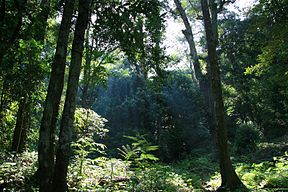Benutzer:Tk/Nationalpark Bukit Baka Bukit Raya
| Nationalpark Gunung Palung | ||
|---|---|---|
| Vegetation im Nationalpark Gunung Palung | ||
| Lage: | Kalimantan Barat, Indonesien | |
| Fläche: | 900 km² | |
| Gründung: | 1990 | |
Der Nationalpark Gunung Palung ist ein 900 km² der großer Nationalpark Indonesiens, gelegen in der Provinz Westkalimantan auf Borneo, nördlich von Ketapang und östlich von Sukadana.
Geschichte
Gunung Palung wurde 1937 als Naturreservat mit einer Fläche von 300 km² unter Schutz gestellt.[1] 1981 wurde das Reservat auf 900 km² erweitert und sein Status in ein Wildreservat umgewandelt.[1] Am 24. März 1990 wurde das Gebiet zum Nationalpark erklärt.[1]
Flora und Fauna
Der Park zeichnet sich durch die Vielfalt seiner Fauna (darunter Orang-Utans) und verschiedene Habitattypen aus, von Mangroven und Frischwassersumpfwald über Tiefland-Überschwemmungswald bis zum Bergwald.
Forschung
1985 richtete Dr. Mark Leighton das Cabang Panti Research Camp im Nationalpark am westlichen Fuß der Gunung Palung-Berge ein, die von der Parkverwaltung betrieben wird. Das Gebiet der Forschungsstation umfasst über 2.100 Hektar, das durch 25 km Pfade erschlossen ist und alle sieben Waldtypen einschließlich des oberen Bergwaldes abdeckt.
Nach einer kurzen Phase der Nichtbesetzung von 2004-2007 wurde die Forschungsstation 2007 mit Geldern zweier Forschungstemas aus den USA wiederaufgebaut. Projekte sind das Gunung Palung Orang-Utan-Projekt und das Gibbons und Leaf-Monkey-Projekt.
Im September 2011 all researchers were expelled from Cabang Panti by the local Park Office after an NGO sent a letter to Jakarta detailing encroachment by illegal logging into the research site. The park justified the reaction by saying they needed all four buildings to house the rotating 4-6 person teams of forest police. After an appeal to Jakarta, researchers were allowed back into the area, however were not granted access to the buildings.
Schutz
A research station (Cabang Panti) was established at the western foot of the main Gunung Palung mountains in 1985, and is owned and operated by the park management authority. Research there has contributed significantly to our understanding of Borneo forest biology.
Illegal, non-mechanized, 'hand logging' has been a problem in the park, especially from ca. 2000-2003. Initiatives by park authorities and NGOs (increased policing, monitoring by microlight, educational activities) contributed to a reduction of illegal activities, however, reduction of these activities has seen a resurgence in illegal logging at several hot-spots. The park was one of the key sites of the EU-funded Illegal Logging Response Center (ILRC, now continued in FLEGT).
Der Orangutan wird als umbrella species für den Schutz des Nationalparks angesehen und ist also an important ecological agent for seed dispersal and seed predation. It is believed that orangutans at Gunung Palung constitute one of the most dense and largest populations on Borneo. A census conducted in 2001, part-funded by The Orangutan Conservancy, gives an estimate of 2500 individual orangutans, about 17% of the estimated population in Borneo and close to 10% of the world’s population.
The Gunung Palung Orangutan Project was established in 1994 by Dr. Cheryl Knott.[2] This project integrates scientific research about orangutan biology and ecology with conservation programs aimed at the preservation of this endangered species and its habitat. Cheryl Knott is conducting scientific investigation of the factors governing orangutan reproduction and population viability, increasing awareness on the local level to encourage support for conservation of the park and community education around the park and capacity-building for National Park Office staff.[3]
In the last decade there has been a great increase in the amount of illegal logging within this national park. This, in conjunction with the fires raging across the Indonesian rainforests, made immediate conservation action in this area of paramount importance. The Gunung Palung Orangutan Conservation Program was initiated to address the threat to orangutans and their habitat.
Tourismus
The park has potential for ecotourism, and has a number of attractive sites for visitors. The only way to gain permission to enter the park is by paying for a package offered by Nasalis Tour and Travel or one of its partners. Nasalis is a for-profit corporation owned and operated by local National Park staff and administrators. As of August 2011, the park had not approved any other tourism companies to operate within the park boundaries.
Einzelnachweise
- ↑ a b c , Center for International Forestry ResearchDecentralisation of Administration, Policy Making and Forest Management in Ketapang District, West Kalimantan. CIFOR, 2001, ISBN 978-979-8764-85-1, S. 42.
- ↑ Website of Gunung Palung Orangutan Project
- ↑ http://www.orangutan.com/projects/gunung-palung
External links
- gunungpalung.net: An information resource about Gunung Palung
- Yayasan Palung: Local conservation organization
- Gunung Palung Orangutan Project

